 W
WThe demons' names are taken from the Ars Goetia, which differs in terms of number and ranking from the Pseudomonarchia Daemonum of Johann Weyer. As a result of multiple translations, there are multiple spellings for some of the names, explained in more detail in the articles concerning them. The sole demon which appears in Pseudomonarchia Daemonum but not in the Ars Goetia is Pruflas.
 W
WAamon, in demonology, is a Marquis of Hell who governs forty infernal legions. Aamon is a demon and the Grand Marquis of Hell and the seventh spirit of the Goetia.
 W
WAgares is a demon described in demonological grimoires.
 W
WThe demons' names are taken from the Ars Goetia, which differs in terms of number and ranking from the Pseudomonarchia Daemonum of Johann Weyer. As a result of multiple translations, there are multiple spellings for some of the names, explained in more detail in the articles concerning them. The sole demon which appears in Pseudomonarchia Daemonum but not in the Ars Goetia is Pruflas.
 W
WAlloces is a demon that appears in demonological grimoires such as the Liber Officiorum Spirituum, Pseudomonarchia Daemonum, and the Lesser Key of Solomon. He is described in the Lesser Key of Solomon and in the Pseudomonarchia Daemonum as a duke, taking the form of a fire-breathing, lion-headed soldier riding a horse. His purported duties include teaching astronomy and liberal sciences, and granting familiars. He is claimed to have 36 legions of demons under his command. In the Liber Officiorum Spirituum, Alloces appears as Allogor or Algor, again a duke, but otherwise with a completely different appearance and abilities -- a spear-toting knight who answers questions, provides advice for plans, and commands only 30 legions of demons. In duplicate entry, Alloces appears as Algor, ruled by the spirit "Orience" (Oriens), again as a knight who explains secrets, but with the additional power of garnering the favor of nobles. According to Rudd, Allocer is opposed by the Shemhamphorasch angel Imamiah.
 W
WThe demons' names are taken from the Ars Goetia, which differs in terms of number and ranking from the Pseudomonarchia Daemonum of Johann Weyer. As a result of multiple translations, there are multiple spellings for some of the names, explained in more detail in the articles concerning them. The sole demon which appears in Pseudomonarchia Daemonum but not in the Ars Goetia is Pruflas.
 W
WThe demons' names are taken from the Ars Goetia, which differs in terms of number and ranking from the Pseudomonarchia Daemonum of Johann Weyer. As a result of multiple translations, there are multiple spellings for some of the names, explained in more detail in the articles concerning them. The sole demon which appears in Pseudomonarchia Daemonum but not in the Ars Goetia is Pruflas.
 W
WThe demons' names are taken from the Ars Goetia, which differs in terms of number and ranking from the Pseudomonarchia Daemonum of Johann Weyer. As a result of multiple translations, there are multiple spellings for some of the names, explained in more detail in the articles concerning them. The sole demon which appears in Pseudomonarchia Daemonum but not in the Ars Goetia is Pruflas.
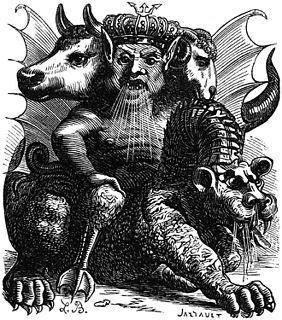 W
WAsmodeus or Ashmedai, also Ashema Deva, is a prince of demons, or in Judeo-Islamic lore the king of the earthly spirits (shedim/jinn), mostly known from the deuterocanonical Book of Tobit, in which he is the primary antagonist. In the Binsfeld's classification of demons, Asmodeus represents lust. The demon is also mentioned in some Talmudic legends; for instance, in the story of the construction of the Temple of Solomon.
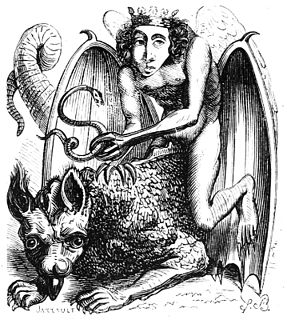 W
WAstaroth, in demonology, is the Great Duke of Hell in the first hierarchy with Beelzebub and Lucifer; he is part of the evil trinity. He is a male figure most likely named after the Near Eastern goddess Astarte.
 W
WBael is a demon described in demonological grimoires such as the Lesser Key of Solomon and the Pseudomonarchia Daemonum and also described in the Dictionnaire Infernal He is described as a hoarsely-voiced king with the power to make men invisible and ruling over sixty-six legions of demons. The Lesser Key of Solomon describes him as appearing in the form of a cat, toad, man, some combination thereof, or other "divers [sic] shapes", while the Pseudomonarchia Daemonum and the Dictionnaire Infernal state that he appears with the heads of a cat, toad, and human simultaneously. Colin de Plancy wonders if Bael is the same as the Canaanite deity Baal, a reasonable conclusion. In the Livre des Esperitz, Bael is described as a king ruled by Orient (Oriens), still possessing the power of invisibility, as well as the power to garner the favor of others, but ruling over only six legions of demons. The Liber Officium Spirituum features Baal, Baall, Boal, or Boall, again a hoarsely-voiced king, with not only powers of invisibility but also sciences and love. Sloane MS 3824 mentions Baal, in "Of the Demon Rulers," as a king ruled by Oriens, attributed with teaching science, (again) granting invisibility, and controlling 250 legions of spirits. Bael appears in later editions of The Grimoire of Pope Honorius, under Astaroth, as a prince whose powers include (again) invisibility and popularity. In the Grand Grimoire, Bael is listed as a subordinate of Lucifuge Rofocale. According to Rudd, Bael is opposed by the Shemhamphorasch angel Vehuiah.
 W
WIn demonology, Barbatos is an earl and duke of Hell, ruling thirty legions of demons and with four kings as his companions to command his legions. He can speak to animals, tell the future, conciliate friends and rulers, and lead men to treasure hidden by the enchantment of magicians.
 W
WIn demonology, Beleth also spelled Bilet, Bileth, Byleth and Bilith is a king of Hell, who has eighty-five legions of demons under his command. He rides a pale horse, and a variety of music is heard before him, according to most authors on demonology and the most known grimoires.
 W
WBelial is a term occurring in the Hebrew Bible which later became personified as the devil in Jewish and Christian texts. Alternate spellings include Baalial, Balial, Belhor, Beliall, Beliar, Berial, and Beliya'al.
 W
WBifrons is a demon described in the demonological grimoires the Lesser Key of Solomon and the Pseudomonarchia Daemonum, as well as being mentioned in the Dictionnaire Infernal. In these works, he is described as an earl who initially appears as a monster before adopting a more human form. His duties include teaching arts and sciences, including astrology, geometry, and the properties of different plants and stones. He also moves bodies into different graves, lights candles over graves, and commands either 6, 26, or 60 legions of spirits. According to Rudd, Bifrons is opposed by the Shemhamphorasch angel Ariel.
 W
WBuer is a spirit that appears in the 16th-century grimoire Pseudomonarchia Daemonum and its derivatives, where he is described as a Great President of Hell, having fifty legions of demons under his command. He appears when the Sun is in Sagittarius. Like Chiron, the chief centaur of Greek mythology, he teaches natural and moral philosophy, logic, and the virtues of all herbs and plants, and is also capable of healing all infirmities and bestows good familiars.
 W
WClauneck is a goetic daemon appearing in the grimoires The Secrets of Solomon , Grimorium Verum and Dictionnaire Infernal. One of the eighteen Servitors of Syrach, Clauneck is well loved by Lucifer, and he is summoned because he has the ability to bestow wealth, either by bringing money over a great distance or by assisting in the discovery of hidden treasure. Clauneck is the demon of wealth, known to be obedient to his summoners, but only to those who show him the proper respect.
 W
WDantalion is the seventy-first demon in the demonological grimoire the Lesser Key of Solomon. He is ranked as a duke who rules 36 legions of spirits, and described as a book-carrying man with multiple faces of varying genders. The powers attributed to him include teaching any art or science, causing love, and showing visions from anywhere in the world. Sloane MS 3824 mentions Dantalion in an invocation in "An Experiment to Obtain your Desire," as well as in the "Experiment of Bleth," where he is attributed with teaching various subjects, exposing secrets, mind control, and creating an illusionary image of any person's face. According to Rudd, Dantalion is opposed by the Shemhamphorasch angel Haiaiel.
 W
WThe demons' names are taken from the Ars Goetia, which differs in terms of number and ranking from the Pseudomonarchia Daemonum of Johann Weyer. As a result of multiple translations, there are multiple spellings for some of the names, explained in more detail in the articles concerning them. The sole demon which appears in Pseudomonarchia Daemonum but not in the Ars Goetia is Pruflas.
 W
WThe demons' names are taken from the Ars Goetia, which differs in terms of number and ranking from the Pseudomonarchia Daemonum of Johann Weyer. As a result of multiple translations, there are multiple spellings for some of the names, explained in more detail in the articles concerning them. The sole demon which appears in Pseudomonarchia Daemonum but not in the Ars Goetia is Pruflas.
 W
WThe demons' names are taken from the Ars Goetia, which differs in terms of number and ranking from the Pseudomonarchia Daemonum of Johann Weyer. As a result of multiple translations, there are multiple spellings for some of the names, explained in more detail in the articles concerning them. The sole demon which appears in Pseudomonarchia Daemonum but not in the Ars Goetia is Pruflas.
 W
WThe demons' names are taken from the Ars Goetia, which differs in terms of number and ranking from the Pseudomonarchia Daemonum of Johann Weyer. As a result of multiple translations, there are multiple spellings for some of the names, explained in more detail in the articles concerning them. The sole demon which appears in Pseudomonarchia Daemonum but not in the Ars Goetia is Pruflas.
 W
WIn demonology, Furcas is a Knight of Hell, and rules 20 legions of demons. He teaches Philosophy, Astronomy, Rhetoric, Logic, Chiromancy and Pyromancy.
 W
WIn demonology, Furfur is a powerful Great Earl of Hell, being the ruler of twenty-six legions of demons. He is a liar unless compelled to enter a magic triangle where he gives true answers to every question, speaking with a rough voice. Furfur causes love between a man and a woman, creates storms, tempests, thunder, lightning, and blasts, and teaches on secret and divine things.
 W
WGaap is a demon that is described in demonological grimoires such as the Lesser Key of Solomon, Johann Weyer's Pseudomonarchia Daemonum, and the Munich Manual of Demonic Magic, as well as Jacques Collin de Plancy's Dictionnaire Infernal,
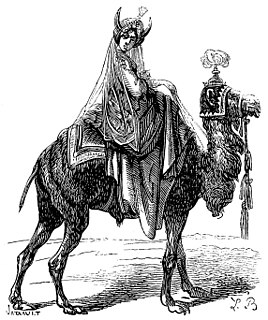 W
WGemory is a demon listed in demonological grimoires.
 W
WIn demonology, Glasya-Labolas is a mighty President of Hell who commands thirty-six legions of demons. He teaches all arts and sciences, in an instant, tells all things past and to come, and is the author and captain of manslaughter and bloodshed. He causes the love of both friends and foes, if desired, and can make a man invisible.
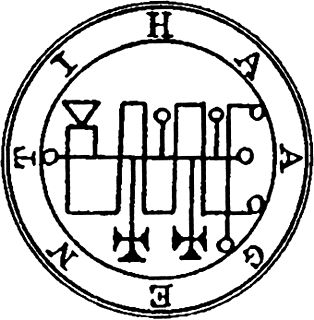 W
WIn demonology, Haagenti is a Great President of Hell, ruling thirty-three legions of demons. He makes men wise by instructing them in every subject, transmutes all metals into gold, and changes wine into water and water into wine.
 W
WIn demonology, Ipos is an Earl and powerful Prince of Hell who has thirty-six legions of demons under his command. He knows and can reveal all things, past, present and future. He can make men witty and valiant.
 W
WIn demonology, Malphas is a major demon.
 W
WIn demonology, Marbas or Barbas is a demon described in the Ars Goetia. He is described as the Great President of Hell governing thirty-six legions of demons. He answers truly on hidden or secret things, causes and heals diseases, gives wisdom and knowledge in mechanical arts, and can change men into other shapes. He is depicted as a great lion that, under the conjurer's request, changes shape into a man.
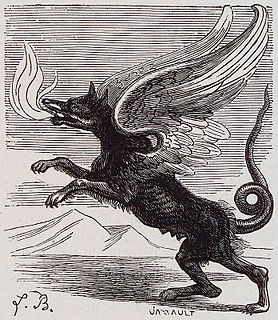 W
WIn demonology, Marchosias is a great and mighty Marquis of Hell, commanding thirty legions of demons. In the Ars Goetia, the first book of The Lesser Key of Solomon, he is depicted as a wolf with gryphon's wings and a serpent's tail, spewing fire from his mouth, but at the request of the magician he may take the form of a man. He is a strong fighter and gives true answers to all questions, and is very faithful to the magician in following his commands. Before his fall he belonged to the angelic order of Dominations, and when he was bound by Solomon he told him that after 1,200 years he hoped to return to Heaven.
 W
WThe demon Naberius was first mentioned by Johann Weyer in 1583. He is supposedly the most valiant Marquess of Hell, and has nineteen legions of demons under his command. He makes men cunning in all arts, but especially in rhetoric, speaking with a hoarse voice. He also restores lost dignities and honors, although to Johann Weyer, he procures the loss of them.
 W
WIn demonology, Orobas is a powerful Great Prince of Hell, having twenty legions of demons under his control.
 W
WIn demonology, Ose, is a Great President of Hell, ruling three legions of demons. He makes men wise in all liberal sciences and gives true answers concerning divine and secret things; he also brings insanity to any person the conjurer wishes, making them believe that they are king and wearing a crown, or a Pope. However, his spells only last 1 hour at a time.
 W
WPaimon is a spirit named in the Lesser Key of Solomon, Johann Weyer's Pseudomonarchia Daemonum, Collin de Plancy's Dictionnaire Infernal, the Livre des Esperitz, the Liber Officiorum Spirituum, The Book of Abramelin, and certain French editions of The Grimoire of Pope Honorius ; as well as British Library, Sloane MS 3824.
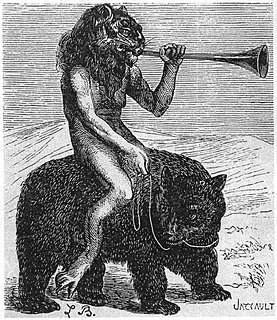 W
WIn demonology, Purson is a Great King of Hell, being served and obeyed by twenty-two legions of demons. He knows of hidden things, can find treasures, and tells past, present, and future. Taking a human or aerial body he answers truly of all secret and divine things of Earth and the creation of the world. He also brings good familiars.
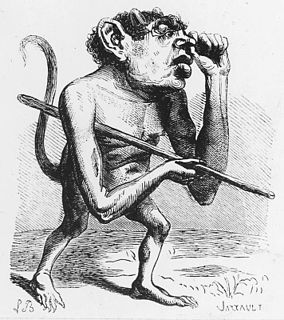 W
WIn demonology, Ronove is a Marquis and Great Earl of Hell, commanding twenty legions of demons. He teaches art, rhetoric, languages, and gives good and loyal servants and the favour of friends and foes.
 W
WThe demons' names are taken from the Ars Goetia, which differs in terms of number and ranking from the Pseudomonarchia Daemonum of Johann Weyer. As a result of multiple translations, there are multiple spellings for some of the names, explained in more detail in the articles concerning them. The sole demon which appears in Pseudomonarchia Daemonum but not in the Ars Goetia is Pruflas.
 W
WThe demons' names are taken from the Ars Goetia, which differs in terms of number and ranking from the Pseudomonarchia Daemonum of Johann Weyer. As a result of multiple translations, there are multiple spellings for some of the names, explained in more detail in the articles concerning them. The sole demon which appears in Pseudomonarchia Daemonum but not in the Ars Goetia is Pruflas.
 W
WThe demons' names are taken from the Ars Goetia, which differs in terms of number and ranking from the Pseudomonarchia Daemonum of Johann Weyer. As a result of multiple translations, there are multiple spellings for some of the names, explained in more detail in the articles concerning them. The sole demon which appears in Pseudomonarchia Daemonum but not in the Ars Goetia is Pruflas.
 W
WThe demons' names are taken from the Ars Goetia, which differs in terms of number and ranking from the Pseudomonarchia Daemonum of Johann Weyer. As a result of multiple translations, there are multiple spellings for some of the names, explained in more detail in the articles concerning them. The sole demon which appears in Pseudomonarchia Daemonum but not in the Ars Goetia is Pruflas.
 W
WThe demons' names are taken from the Ars Goetia, which differs in terms of number and ranking from the Pseudomonarchia Daemonum of Johann Weyer. As a result of multiple translations, there are multiple spellings for some of the names, explained in more detail in the articles concerning them. The sole demon which appears in Pseudomonarchia Daemonum but not in the Ars Goetia is Pruflas.
 W
WThe demons' names are taken from the Ars Goetia, which differs in terms of number and ranking from the Pseudomonarchia Daemonum of Johann Weyer. As a result of multiple translations, there are multiple spellings for some of the names, explained in more detail in the articles concerning them. The sole demon which appears in Pseudomonarchia Daemonum but not in the Ars Goetia is Pruflas.
 W
WValac is a demon described in the goetic grimoires The Lesser Key of Solomon, Johann Weyer's Pseudomonarchia Daemonum, the Liber Officiorum Spirituum, and in the Munich Manual of Demonic Magic as an angelically winged boy riding a two-headed dragon, attributed with the power of finding treasures.
 W
WIn demonology, Vual is a mighty Great Duke of Hell, commanding thirty-seven legions of demons. He gives the love of women, causes friendship between friends and foes, and tells things past, present and to come.
 W
WThe demons' names are taken from the Ars Goetia, which differs in terms of number and ranking from the Pseudomonarchia Daemonum of Johann Weyer. As a result of multiple translations, there are multiple spellings for some of the names, explained in more detail in the articles concerning them. The sole demon which appears in Pseudomonarchia Daemonum but not in the Ars Goetia is Pruflas.
 W
WThe demons' names are taken from the Ars Goetia, which differs in terms of number and ranking from the Pseudomonarchia Daemonum of Johann Weyer. As a result of multiple translations, there are multiple spellings for some of the names, explained in more detail in the articles concerning them. The sole demon which appears in Pseudomonarchia Daemonum but not in the Ars Goetia is Pruflas.